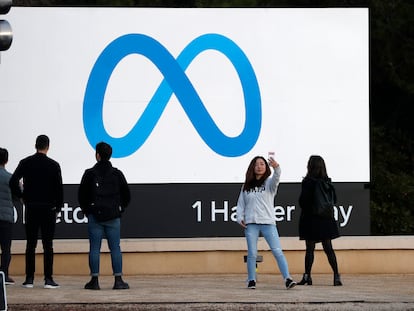‘Bold Glamour’ filter ignites TikTok: ‘It should be illegal’
A new hyperrealistic effect that makes users look young and beautiful rekindles the debate on beauty standards and mental health

By now, it is an everyday thing. No matter where you go, be it a mountain lookout or a promenade by the beach, you are very likely to find a string of teens who, with outstretched arms or aided by accessories, take vertical videos of themselves. Some of them may remain private, but many will end up on TikTok, exposed to the judgment of the viewers. Social media is ruthless, and the peer pressure that teenagers can face is brutal. In this sense, some critical voices are warning of the risks of a new filter that is revolutionizing TikTok.
The filter, called “Bold Glamour,” applies an algorithm through which the face is rejuvenated, wrinkles disappear, and facial features are highlighted. If this sounds like something you have seen before, it is because you have – but not like this. This new filter transforms the face, making it look younger with unprecedented accuracy.
‘This filter should be illegal’
The filter works in the usual way: open TikTok, tap the “+” icon and then “Effects,” where you will find “Bold Glamour” represented by two faces (it is not yet available in all markets, so it might not appear in your app). Once activated, it uses artificial intelligence with surgical precision to remove wrinkles, paleness, lines and basically everything that makes a face ugly.
The realism of this new image can be shocking for an adult, who cannot help but wonder: What is the impact of the algorithmic application of instant beauty on a teenager? “This filter should be illegal,” reflects popular tiktoker Kelly Strack. She illustrates this statement with the image of her face, flawless and made up, supposedly just out of bed. Then the viewer becomes aware of the ruse when she turns the filter off and becomes a natural young woman who just woke up with bags under her eyes and no makeup.
The transformation takes place in real time, right before your eyes. Spotting all the changes might seem like an easy task, but it is not: while some are fairly obvious (the perfect makeup, the lack of wrinkles) others are not so evident, such as the outline of the face.
“Basing all our worth on our image is harmful”
The tyranny of beauty is harshly enforced on social media, and this filter’s realism has come to fuel a continuing debate on Instagram and TikTok: to what extent are teens enslaved by beauty standards? “Basing all our worth on our image is harmful,” explains psychologist Juan Bautista Jordán, who treats some young patients with social media-related related conditions. The expert alludes to the “narcissist reinforcement” that comes with these beauty filters – as well as their consequences: “they can cause a mental block in very early stages of development.”
But what do the influencers think? Spanish tiktoker Claudia García often uses filters to present herself before her more than five million followers, and while she acknowledges that filters can be “fun,” like the ones that replace your face or change the color of your hair or eyebrows, “some filters can cause a lot of insecurity.” García refers to those which “retouch your face, make your lips bigger, retouch your cheekbones [and] make your head smaller.” These filters show the user, she says, “in a way that is supposed to be perfect or beautiful and that ends up creating a lot of complexes, and I think that people shouldn’t use them.”
This veneer is not something new on TikTok. In April 2020, mzznofilter, an Australian user, went viral with the hashtag #catfish after posting a video of herself that had been manipulated by Snapchat’s algorithms, and then comparing it to her actual look. The difference was obvious and tacky, and the video caused the social network to flood with similar sequences in which users posted their own before and after images, filtered and unfiltered.
The “Bold Glamour” filter raises the bar for perfection in the application of the algorithm, but also in the canons of beauty that govern millions of young people on social media.
Sign up for our weekly newsletter to get more English-language news coverage from EL PAÍS USA Edition
Tu suscripción se está usando en otro dispositivo
¿Quieres añadir otro usuario a tu suscripción?
Si continúas leyendo en este dispositivo, no se podrá leer en el otro.
FlechaTu suscripción se está usando en otro dispositivo y solo puedes acceder a EL PAÍS desde un dispositivo a la vez.
Si quieres compartir tu cuenta, cambia tu suscripción a la modalidad Premium, así podrás añadir otro usuario. Cada uno accederá con su propia cuenta de email, lo que os permitirá personalizar vuestra experiencia en EL PAÍS.
¿Tienes una suscripción de empresa? Accede aquí para contratar más cuentas.
En el caso de no saber quién está usando tu cuenta, te recomendamos cambiar tu contraseña aquí.
Si decides continuar compartiendo tu cuenta, este mensaje se mostrará en tu dispositivo y en el de la otra persona que está usando tu cuenta de forma indefinida, afectando a tu experiencia de lectura. Puedes consultar aquí los términos y condiciones de la suscripción digital.
More information
Archived In
Últimas noticias
Venezuela authorizes the release of another 87 political prisoners
There is as much life left to discover on planet Earth as that which is already known
Dozens presumed dead, around 100 injured in fire at Swiss Alps bar during New Year’s celebration
Is porn for women different from conventional porn? We spoke to those who make it
Most viewed
- David King, chemist: ‘There are scientists studying how to cool the planet; nobody should stop these experiments from happening’
- Reinhard Genzel, Nobel laureate in physics: ‘One-minute videos will never give you the truth’
- Oona Chaplin: ‘I told James Cameron that I was living in a treehouse and starting a permaculture project with a friend’
- Sinaloa Cartel war is taking its toll on Los Chapitos
- The Interoceanic Train, the Mexican alternative to the Panama Canal











































